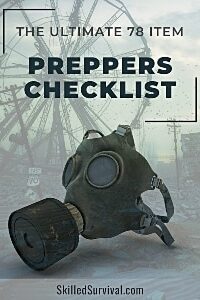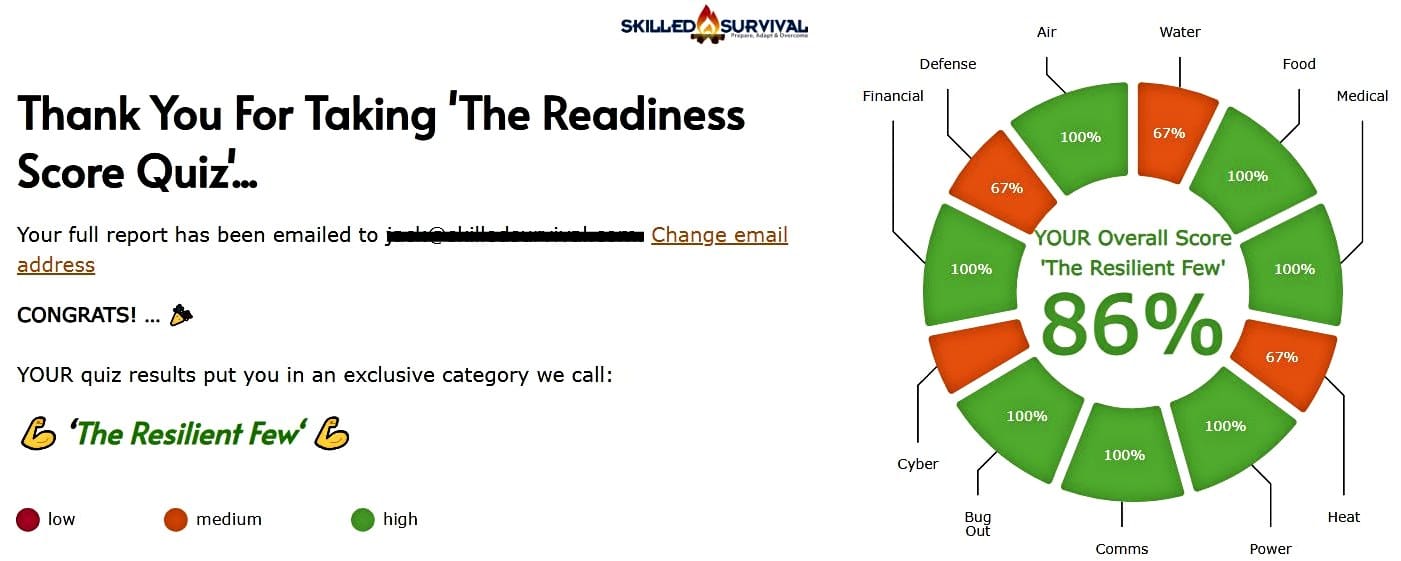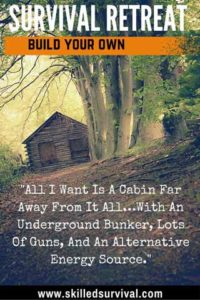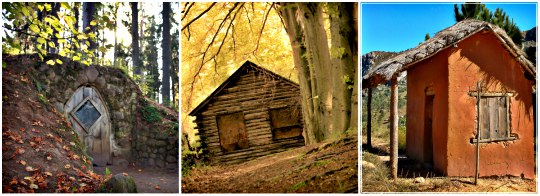Today I’ve got something really important to share…
A Complete Guide To Building Your Own Survival Retreat
Because there are many great reasons to build one:
- Maybe you want to prepare for doomsday or “SHTF”
- Perhaps you want a backup shelter if you lose your primary home
- Or maybe you’re just desperate to get off the grid
Whatever your motive, having your own survival retreat is one of the best ways to ensure your future safety.
TOPICS IN THIS GUIDE… ↓(click to jump)
- Where’s The Best Place To Build
- Best DIY Structure Options…
- Prepper Storage and Supplies
- Fending Off Unwanted Guests
- Retreat Budget Considerations
- Retreat Legal Considerations

Want a free 78 item bug out bag checklist?
Enter your email below to instantly download this Complete Checklist PDF. No purchase necessary. 👇 👇Where To Build Your Survival Retreat
Before you start construction, realize that this is no light undertaking.
You can get into legal and physical trouble if you don’t take this project seriously.
But when done right, it can be one of the most rewarding survival projects you’ve ever accomplished.
↓ Super shelter building in the woods
It is a good idea to spend time searching for the right piece of land.
A project like this only requires a small acreage.
Heck, one acre is enough; anything more is a bonus.
However, this decision is very dependent on your budget.
Unfortunately, more land costs more money.
The more money you spend, the better the piece of property you will get.
But if you skimp yourself on this investment or don’t plan this step out, you’ll regret it later.
Here are a few considerations:
Water is necessary.
If there’s no natural water or a way to dig yourself a well, it will not be a safe place for survival.
Ideally, there’s a creek, stream, or river nearby that can act as a source of both food and water.
Fish, and animals will hang out around water sources for the same reasons you do.
Fertile soil is best.
This might be difficult to find if you decide to take refuge in the desert.
But in forested areas or the mountains, buying tillable land to grow food is important, especially for survival.
You must have adequate cover.
Wherever you place your cabin, adobe hut, earth-sheltered home, or other structures you want some concealment.
Be it large rocks, sand dunes, trees, shrubs, brush, or cliffs – whatever – making sure that your survival retreat is naturally camouflaged.
This will boost your chances of avoiding unnecessary confrontations.
So cover it up.
3 Types Of Simple Survival Retreats (And How To Build Them)
There are numerous directions you can go at this point.
You can build a treehouse like the Swiss Family Robinson (although it is inadvisable considering how difficult it would be to get food and water up into the tree).
So instead of covering all possibilities, I will focus on three types of buildings that are the most common and most effective for survival purposes.
1. Survival Cabins
The Advantages:
Cabins are, without a doubt, one of your best options.
When built correctly, they are sturdy, durable, long-lived, relatively cheap, and easy to construct.
Designing the layout of a cabin is simple – often, it’s just a square.
Because they are built from thick timbre, they naturally blend into the environment (like forests or mountains), are highly windproof, and are waterproof.
Buy a Cabin Kit or DIY?
If you search online, there are a lot of pre-designed cabin kits online that you can purchase and have delivered and constructed wherever you want.
Here are a few examples:
But many people strongly urge against buying a cabin kit.
These shelters are built at a factory, disassembled, shipped to you, and rebuilt on-site. But worse than that, they are highly susceptible to excessive “settling.”
Settling happens over time as the wood dries and warps. Settling creates gaps in the floor and wall planks and causes other deformities to emerge.
These kits produce shelters that are expensive, challenging to set up, and all too often of poor quality.
So it’s recommended you build the cabin yourself, especially if you’re a DIY survivalist.
↓ Building an Off-Grid Log Cabin using Hand Tools
Now there are many variables and options to consider when planning to build your cabin.
The first decision is the species of tree you’ll use for your log cabin.
Here’s an excellent article providing an overview of all the options, pros and cons, to help with your selection process:
Choosing Your Wood Species
And if you plan to use trees from your property, it’s still good to research the pros and cons of that particular species before starting.
That way, you’ll understand the pros and cons of the species and can plan accordingly.
It’s also imperative you understand the debarking and seasoning process. If not properly debarked and seasoned, you’ll get premature rot and excessive settling with your cabin.
The second decision you must make is the stacking and interlocking method you intend to use.
Here are some of the options you can research further:
- Full-Round Butt & Pass
- Handcrafted Saddle notch
- Traditional Butt & Pass
- Swedish Cope Saddle notch
- Timber Dovetail
- D-Log Dovetail
- Variable Stack Height Butt & Pass
- Hand-Scribed Saddle notch
- Round Vertical Post
- Square Vertical Post
This web page has a close-up image of each option to get an idea of how they work.
Again, each of these building methods has positives and negatives.
However, for simplicity, I recommend sticking with either the “Butt & Pass” method or the “notch” method.
Here’s a video using the simple saddle notch method.
↓ Building log cabin: Saddle notch a log
The third and final part of the log cabin build is the chinking process.
Chinking is the process of filling in the gaps between the logs to improve insulation.
When this is done correctly, chinking keeps the bugs, rodents, and the cold out; while keeping warm in.
Final Log Cabin Tips
One way to try and save a few dollars on this project is to use timber from your property.
I’ve heard some examples of survivalists building a simple log cabin for around $500 (doesn’t include your time though!)
In my opinion, a simple one-room log cabin is easiest to build using the “butt-and-pass” method.
See the below video for some extra insight into a “notching” vs. a “butt-and-pass.”
↓ I had a question on my butt and pass corners

Want a free 78 item preppers checklist?
Enter your email below to instantly download this Complete Checklist PDF. No purchase necessary. 👇 👇2. Earth Sheltered Homes
An earth shelter is my favorite survival retreat options.
It uses the Earth as a natural layer of insulation; it is extremely energy efficient and blends in with the natural environment better than any other shelter style.
There are two main types of earth-sheltered homes:
Some are built into the sides of hills, like hobbit holes – this provides warm insulation through cold months and cool insulation during hot ones.
It conserves rainwater and heals its scars on the environment, and because the body of the structure is mostly underground, these are tough to spot from a distance.
Caves make for great homes – although there are not many windows.
Some people will accentuate a cave by hollowing it out to a greater extent, making it deeper and creating more living space.
The only construction you need to do is at the mouth of the cave, where you install a front door.
These types of shelters are also largely impervious to hurricanes, tornadoes, earthquakes, wildfires, and other natural disasters.
Earth-sheltered homes make for some of the world’s most sustainable and efficient survival shelters.
The roofs are typically covered with soil and vegetation, so these buildings survive well in harsh weather (especially high winds).
Here’s an excellent dug out shelter build worth watching:
↓ Building My BEST DUGOUT EVER
Here’s a 2-minute time-lapse video of an Earth Bag House being built.
↓ An Earthbag House Time Lapse
3. Survival Adobe Huts
These are your best bet when planning your survival retreat in the desert.
Native Americans have used adobe huts for centuries.
In fact, it is one of the oldest building materials currently in use, and for a multitude of reasons:
Adobe huts are made from the soil and dirt of the surrounding earth, so they blend into their environments perfectly.
They also offer fantastic thermal mass material holding both hot and cold and are simple to build.
Because most adobe huts have flat roofs, they are not a good choice for any region that gets snow or heavy rainfall.
But again, they are ideal for dry desert environments.
Here’s a primitive abode hut being built with only primitive tools.
I know you can do it with the advantage of some hand tools (worth watching the entire video!)
↓ Primitive Technology: Tiled Roof Hut

Storage Areas And Supply List
To keep a stash of goods hidden, you’ll need to create a space for supply storage:
Storage cellars are a simple solution.
Dig a hole beneath your cabin, earth shelter, or adobe hut – making it as large as necessary and lining the floor and walls with stones.
Cover it up with some planks of wood (like floorboards) or a hatch door.
This also serves as a type of cooling chamber because of its subsurface, which is dark and lined with stone.
So it will help keep perishable food fresh for a little while longer.
Don’t expect miracles tho.
Storage units can be created in smaller versions of your survival shelter:
Build a smaller adobe hut outside your larger one, a little wooden shed outside your cabin, or another miniature earth shelter storage unit.
This is effective for storing just about everything, but you must invest in solid doors and good locks to keep it safe.
The stash of supplies you keep in your survival shelter is personal, but here are a few staples to get you started:
WATER
Start with survival water storage techniques. Keep a couple of 50-gallon drums outside for a rainwater collection system.
Buy bottled water packages, and ensure a water filtration system or iodine for sterilization.
NON PERISHABLES
Non-perishables are invaluable in any disaster or survival situation.
Canned goods, packaged and sealed goods, dehydrated foods, Hostess Twinkies – anything with a long shelf life.
Bring a basket full of non-perishables every time you visit our survival shelter and add to your stash.
SEEDS
Packaged seeds for planting produce.
Storing these could prove invaluable when you had to make a home out of your survival retreat.
Including various vegetables, fruits, and legume seeds is always an excellent preparation idea.
Tools like handsaws, hammers, and nails, screws and screwdrivers, hatchets, axes, shovels are extremely useful.
Gardening tools (i.e., pots, pans, utensils, plates, and bowls) make life a lot easier.
WEAPONS & AMMO
Everything you can think of that falls under this category is on the table – it all just depends on what you trust to keep at your survival retreat.
ENTERTAINMENT
Entertainment can be just as important as any tool or weapon you bring to your shelter.
If you stay there for a while, books, board games, instruments, and puzzles will be the best way to fight cabin fever.
Your sanity is important to your health, right?
MEDICATION & MEDICAL SUPPLIES
Medication and medical supplies are paramount for survival.
You can leave it as simple as a first-aid kit or custom-build an emergency medical kit for your survival shelter.
Here is an excellent guide to making a medical kit.
But be warned: medications all have an expiration date.
If you keep these stored, you will have to diligently replace them as they expire – which can be time-consuming and expensive.
Supplies like band-aids, bandages, gauze, splints, swabs, etc., never go bad.
HUNTING GEAR
Fishing and hunting supplies are critical for obvious reasons.

Want a free 78 item preppers checklist?
Enter your email below to instantly download this Complete Checklist PDF. No purchase necessary. 👇 👇Keeping Out Unwanted Guests
The most consistent chore every owner of a cabin or second home struggles with is the threat of invasion.
And it is especially difficult with small, off-the-grid shelters.
Animals and insects are your worst enemies.
Keeping rodents, birds, beasts, and bugs out will be a constant endeavor.
- Tightly seal windows and doors, and make sure to close up any spaces in doorframes.
- Try to avoid having high rafters, as birds like to nest in areas like this. Similarly, do not let the roof overhang become infested by birds.
- Keep sticky and snap traps for mice, rats, and rodents that want to burrow or sneak in. Lay these by entrances and especially around the food cache.
You should also prepare to secure your shelter against other human beings.
Even if you think your shelter is well hidden and camouflaged, losing your backup survival stash or, worst, having someone commandeer your survival retreat would be a shame.
Make sure you invest in a few home fortification techniques.
- Install heavy doors, deadbolts, and padlocks
- Reinforce doorframes
- Add window bars and window locks
- Keep everything inside hidden – if someone can see you have valuable things inside, they are more likely to try a break-in. Do not tempt people. Create spaces to hide everything; it is best if your shelter looks abandoned when you are not there.
- Be conspicuous – you do not have to disguise your survival shelter as some long-abandoned ruin (although that would probably deter many would-be intruders), especially if you plan on using this place recreationally. There is no reason you can’t make it look nice. But the bigger you build, and the more lavish the house becomes, the more attention it will draw.
- Consider a few non-lethal booby traps to deter anyone trying to sneak onto your survival retreat property.
A Survival Retreat’s Budget Considerations
I am sorry to say, but a survival retreat costs time and money.
You can do it on a shoestring, but the more capital you have, the better equipped you’ll be.
Throughout my research, I found drastically different estimates and reports – the cheapest was $1750, and the most expensive was six digits.
There is no upper limit to what you can spend on the construction and preparation of your survival retreat, but there is a minimum price.
Whatever you choose to devote to this project is totally dependent on your financial circumstances.
If you’re on a shoestring budget, you can consider teaming up with friends and family to share the costs and labor.
You could also investigate some financing options.
If you don’t mind a small monthly payment in exchange for a quaint survival retreat, you may be able to make it happen that way.
Why can’t someone go deep into the wilderness, find a special, super-secret hiding spot, harvest the lumber right there, and build a squatter’s cabin for next to nothing?
Well, that is an excellent segue into the next section:
Legal Considerations
Pioneers, miners, loggers, hunters, and trappers all used to have the freedom of posting up on any mountain or within any forest they so desired.
This is sadly not the case anymore.
Erecting a structure on private or government property without the proper paperwork could lead to fines, or worse – some US states, like Nevada, uphold “stand your ground laws” that might authorize property owners to open fire on squatters.
It is, in fact, very rare that squatters are awarded property rights.
You are more likely to get shot at and evicted.
So you will have to buy some land; wherever you choose, it might have unique building laws or structure codes.
In most cases, for building a small one or two-room survival shelter, a building permit will not be required.
But if they are, you will be looking at a hefty fine.
Better safe than sorry; it only takes a few minutes to check.
A quick internet search or a call to your state government office or building inspections will tell you all you need to know to get started.
The Final Words
Having a survival retreat will offer great peace of mind.
Knowing that you have a bug-out location stocked, armed, and ready to occupy should a major disaster strike.
And in the meantime, before the apocalypse, it can be used as a quiet vacation spot.
Your reason to get outdoors and be at peace with nature.
There is very little downside to owning a piece of property and building a survival shelter there.
You could even make it a full-time survival homestead if you plan properly.

Prepare, Adapt & Overcome,
P.s. - I just found out 2 out of 3 Americans don’t feel prepared for a 3 day disaster!!!
I guess this goes to show how modern society continues to embrace ‘living a fragile life.’ What’s crazy is… it’s so easy to fix.
To make sure YOU have the basics, watch our FREE training on “10 Simple Steps To Basic Preparedness” that shows you HOW.
Nothing crazy here… this isn’t doomsday prepping... just the basics every responsible adult should have before a disaster strikes.Why You Can Trust Skilled Survival...
Go here now to review a full breakdown of:
- Who We Are
- Our Credentials
- Our Mission
- & Product Recommendations...
Here are a few highlights of our teams credentials & certifications:
- Certified Member of a Mountain Search & Rescue Organization
- Plant Emergency & Safety Leader for a Major Food Manufacturer
- Member of the 10TH Mountain Division Hut Association
- Certifications: Avalanche 1, WFR, CPR
- Official Gear Tester for Numerous Outdoor Gear Companies
- Countless Multiday Backpacking trips into Remote Wilderness
- Bachelor's Degree In Mechanical Engineering
- Bachelor's Degree In Civil Engineering
- Bachelor's Degree In Biomedical Engineering
"It takes 20 years to build a reputation and five minutes to ruin it." - Warren Buffett
We're fully aware that trust is NOT something you GET but is EARNED.
And we'll continue to earn YOUR trust through our forthright and honest approach with each new Blog Post, Guide & Product we create...
P.s - I just took this FREE 60-second 'Readiness Score Quiz'👇
AND... I've still got a few gaps in my preps...🤔 But at least, I'm not part of 'The Fragile Masses'. 👍 Find out where YOU stand by answering a few questions...

Recommended Reading
Best Bug Out Bag: The Pack Most-Trusted By Experts
You deserve a bug out bag you can trust; a pack to protect all your gear. Here's how to find a good one and avoid making amateur mistakes.
Bug Out Bag Weight: How To Reduce Every Deadly Pound
Advanced tactics to reduce your bug out bag weight because a heavy bug out pack will slow you down. And a slow getaway can get you killed.
Bug Out Location: How To Find One You Can Afford
There are 7 must-have qualities for a perfect bug out location . I show exactly what they are and how to find an affordable one in minutes...
Bug Out Vehicle: The Best Rigs To Escape The Chaos
A good bug out vehicle will help you make it out of chao to safety FAST. I show you the best options and capabilities to design your own rig.
Bug In Vs Bug Out? Smart Or Guaranteed Death Trap
One of the hardest SHTF decisions is: Bug In vs Bug Out. You should plan for both because there some situations where you may have to leave.
Bug Out Bike: THE Most Reliable Way To Escape
A simple 6 step action plan to turn a regular bike into a badass, terrain crushing bug out bike - to escape the chaos without traffic jams.






